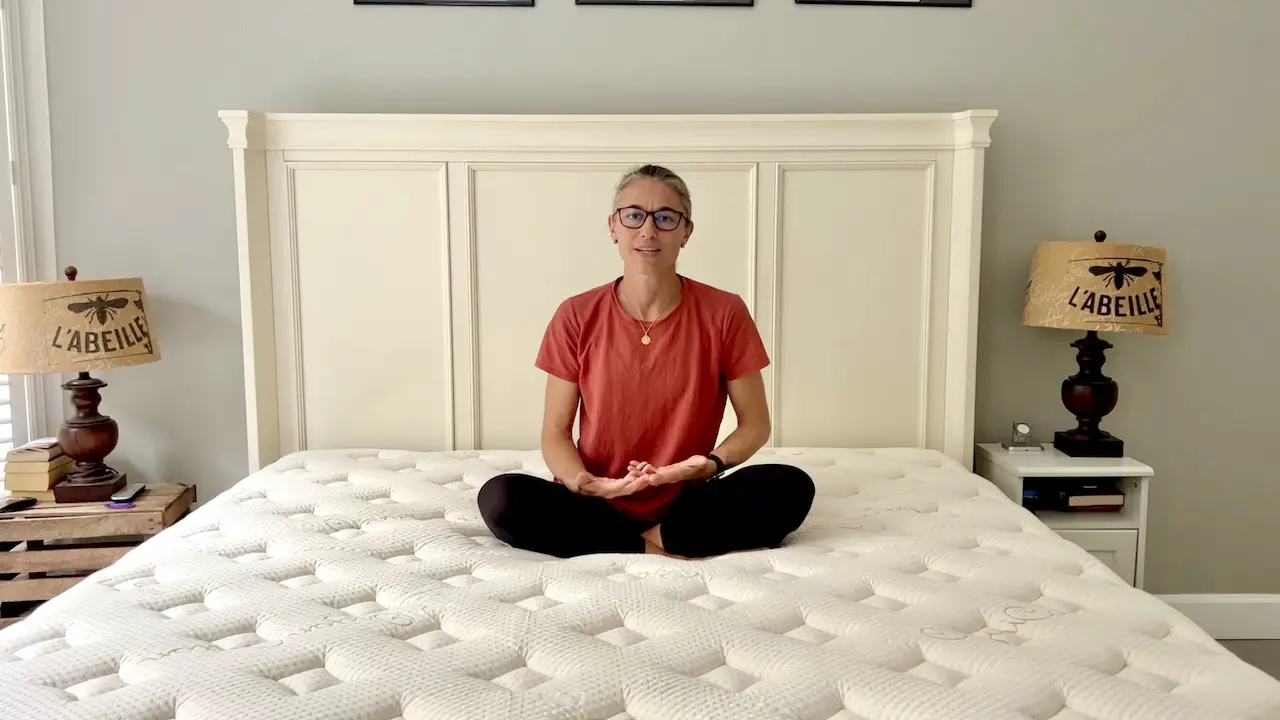ARE LATEX MATTRESSES GOOD
A Comprehensive Guide
Latex mattresses have gained popularity in recent years as a natural, durable, and supportive option for sleepers. It also happens to be our favorite support foam in mattresses, here at Non-Biased Reviews. Remember, however, that mattress preferences are a very personal thing, and it does not mean latex mattresses have to be your favorite.
So let’s explore whether a latex mattress is the right choice for you. We’ll look at the benefits, pros and cons, and key features of latex mattresses to help you decide. We’ll answer common questions, such as “Is latex healthy to sleep on?” “Is latex better than memory foam?” and “Does latex sleep hot?”
Table of Contents
What is a Latex Mattress?
Latex mattresses are made from either natural latex, synthetic latex, or a blend of both. Natural latex is derived from the sap of rubber trees, making it an eco-friendly and sustainable material. There are two main types of latex production processes:
- Dunlop Latex: A denser and more durable form of latex, Dunlop is commonly used for the mattress base layers.
- Talalay Latex: This type is softer and more uniform in texture, making it ideal for comfort layers.
Latex mattresses are celebrated for their durability, support, and eco-friendly properties. They tend to have a responsive, buoyant feel, which is often compared to a gentle “bounce,” and can suit a range of sleep preferences, from firm to plush.
In a mattress, “bounce” is a positive concept, which allows a foam to “bounce back” to its original shape as soon as the body leaves the area. Foam such as latex are called “responsive” – the have bounce and make moving, tossing, turning easy, and provides better durability than more traditional foams.
Is Latex Healthy to Sleep On?
The Health Benefits of Sleeping on Latex
Latex mattresses, especially those made from 100% natural latex, are generally considered safe and healthy to sleep on. Here are a few reasons why:
Hypoallergenic Properties: Natural latex is naturally resistant to dust mites, mold, and mildew. This can benefit those with allergies or sensitivities to common allergens (mold, mildew, dust, dust mites, etc.).
Chemical-Free: Organic and natural latex mattresses contain fewer chemicals and artificial substances, reducing the exposure to potential toxins.
Support for Proper Alignment: Latex conforms to the body, which promotes spinal alignment, alleviating pressure points and reducing strain on the back and neck.
Overall, latex mattresses provide a healthy sleep environment by limiting allergens, minimizing chemical exposure, and offering supportive comfort for proper body alignment.
Is Latex Better than Memory Foam?
Comparing Latex and Memory Foam Mattresses
Both latex and memory foam mattresses offer unique sleep experiences. Let’s break down the differences:
Responsiveness: Latex is a more responsive material than memory foam, providing a slight “bounce” that allows for easy movement. Memory foam, by contrast, has a slow-response contouring effect, which some sleepers enjoy, but can make changing positions harder.
Breathability: Latex is naturally more breathable and heat-resistant, making it a better choice for hot sleepers. Memory foam tends to trap heat due to its dense structure, which can cause discomfort for those who overheat at night.
Durability: Latex is generally more durable than memory foam. High-quality latex mattresses can last 10–15 years, while memory foam tends to break down within 7–10 years.
Eco-Friendliness: Natural latex is a renewable resource, making it an environmentally friendly choice. Many memory foam mattresses are petroleum-based, which impacts their environmental footprint.
Verdict: For those seeking a natural, durable, and temperature-regulating mattress, latex is often a better choice than memory foam.
Is a Latex Bed Good for Your Back?
Latex Mattresses and Back Support
A latex mattress can be an excellent option for back support due to its responsive, adaptive nature:
Spinal Alignment: Latex provides uniform support across the mattress, helping maintain natural spinal alignment. This support is crucial for those with back pain, as it reduces pressure points and evenly distributes body weight.
Pressure Relief: Latex adapts to the body without excessive sinking, which can help relieve pressure in areas like the shoulders, hips, and lower back.
Customizable Firmness: Many latex mattresses offer customizable firmness levels, allowing sleepers to choose a firmness level that suits their specific needs.
A latex bed is especially beneficial for individuals with back pain, as it combines supportive firmness with slight cushioning, reducing strain and discomfort.
Does Latex Sleep Hot?
Latex mattresses are generally cooler than many other mattress types. Here’s why:
Breathable Structure: Latex has an open-cell structure that allows for better air circulation. This feature naturally reduces heat buildup and creates a more comfortable sleeping temperature.
Temperature Neutrality: Unlike memory foam, which can retain body heat, latex does not absorb heat as readily. Instead, it disperses excess body heat, helping keep the mattress surface cool.
Moisture-Wicking Properties: Natural latex can also wick away moisture, which can further improve comfort and cooling throughout the night.
These qualities make latex a great choice for hot sleepers or those who live in warmer climates.
Why is Latex a Naturally Heat-Resistant Material for Mattresses?
Latex is inherently heat-resistant due to its open-cell structure and natural properties:
Open-Cell Structure: Latex’s unique structure allows for improved airflow and ventilation, which helps to regulate temperature.
Density and Resilience: Latex’s composition doesn’t retain heat as much as materials like memory foam. The material’s resilience also helps it remain cool over time.
Moisture-Wicking Ability: Latex can wick moisture away from the body, further aiding in temperature regulation.
These natural properties make latex an ideal choice for sleepers who want a cooler, more breathable mattress.
Are Latex Mattresses Safe for Those with Latex Allergies?
It is important to be vigilant when choosing a latex mattress if you have a latex allergy. It is important to note that the
Latex mattresses can still be a viable option for people with latex allergies, as long as your body does not come in contact with the latex layer, however your allergy could be triggered when breathing in latex, so if you have an airborne latex allergy, be extra vigilant.
Some precautions you can take if you have a latex allergy:
Encased Layers: Many latex mattresses are encased in hypoallergenic covers (i.e., organic cotton covers), preventing direct contact with the latex itself.
Low Allergen Risk: The latex used in mattresses is often treated or manufactured in a way that removes many of the proteins responsible for latex allergies. The foam is typically cold-dipped, not vulcanized, which helps reduce airbone latex particles.
Synthetic Latex Option: For those who are highly sensitive, synthetic latex or a latex-alternative mattress may be a safer option. There are many mattress foams on the mattress, and some mattress companies have now engineered foam with similar responsiveness and properties. We recommend Nolah’s proprietary AirFoam as a great alternative.
It is still recommended to check with a healthcare provider before purchasing a latex mattress if you have a severe allergy. One option if you have doubt, would be to start with a latex pillow to see how your body reacts, prior to investing into a new mattress.
Pros and Cons of Latex Mattresses
Pros of Latex Mattresses
- Durability: Latex mattresses are highly durable, often lasting 10–15 years or more.
- Natural Materials: Many latex mattresses are made with organic and sustainable materials.
- Support and Comfort: Latex offers a balanced mix of support and comfort, adapting to the body without sinking.
- Breathability: Latex mattresses’ open-cell structure and moisture-wicking properties help keep the mattress cool.
- Hypoallergenic: Natural latex resists dust mites, mold, and mildew.
Cons of Latex Mattresses
- Cost: Latex mattresses tend to be more expensive than traditional memory foam or innerspring mattresses.
- Weight: Latex is a dense material, making these mattresses heavier and harder to move.
- Firmness: Latex can feel firm to some sleepers, especially side sleepers who prefer a softer feel.
- Allergy Concerns: Those with latex allergies need to consider the potential risks.
Are Latex Mattresses Good? - Conclusion
Latex mattresses offer a range of benefits, from durability and breathability to support and eco-friendliness, making them a strong option for those seeking a natural, long-lasting mattress. However, they may not be ideal for everyone, particularly those who prefer a softer feel or have severe latex allergies.
In conclusion, latex mattresses are an excellent option for many sleepers, particularly those with back pain, those who sleep hot, and those who prioritize eco-friendly materials. If you are looking for a mattress that combines comfort, support, and durability, a latex mattress could be a good investment in your sleep quality.
References
- National Library of Medicine. (1999). Protein and Allergen Analysis of Latex Mattresses. Retrieved from https://pubmed.ncbi.nlm.nih.gov/10436396/
- Wikipedia. Foam Latex. Retrieved from https://en.wikipedia.org/wiki/Foam_latex
FAQ
Most frequent questions and answers
Yes, latex mattresses are known for their durability, often lasting 10–15 years or more due to the resilience of natural latex.
Latex is naturally breathable and resistant to heat buildup, making it a great option for hot sleepers who need a cooler sleeping surface.
Most latex mattresses are encased in hypoallergenic covers, which can help reduce exposure. However, those with severe latex allergies should consult a doctor.
Latex is more responsive and breathable than memory foam, offering a slight bounce, better airflow, and a cooler sleep experience.
Yes, natural latex is a renewable resource and often used in organic, eco-friendly mattresses, making it a sustainable choice for environmentally conscious sleepers.
Are latex mattresses durable?
Yes, latex mattresses are known for their durability, often lasting 10–15 years or more due to the resilience of natural latex.
Is a latex mattress good for hot sleepers?
Latex is naturally breathable and resistant to heat buildup, making it a great option for hot sleepers who need a cooler sleeping surface.
Can people with latex allergies use latex mattresses?
Most latex mattresses are encased in hypoallergenic covers, which can help reduce exposure. However, those with severe latex allergies should consult a doctor.
How is latex different from memory foam?
Latex is more responsive and breathable than memory foam, offering a slight bounce, better airflow, and a cooler sleep experience.
Are latex mattresses environmentally friendly?
Yes, natural latex is a renewable resource and often used in organic, eco-friendly mattresses, making it a sustainable choice for environmentally conscious sleepers.
Share this deal with a friend!

Laura Georgieff
Laura is a mother of three who did not sleep through the night for the first 5.5 years of her kids' lives. She is passionate about sleep quality and loves sharing her experience and knowledge of all thing bedding! It is her mission to help you make the best decisions when it comes to sleep and help you get the best deal on the market!






